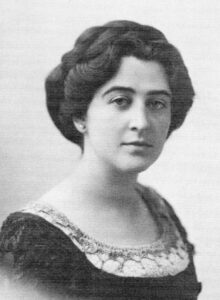The information below has been compiled from a variety of sources. If the reader has access to information that can be documented and that will correct or add to this woman’s biographical information, please contact the Nevada Women’s History Project.

At a glance:
Birth: January 6, 1885 in Alameda, California
Death: February 4, 1987 in San Francisco, California
Maiden Name: Moore
Race/nationality/ethnic background: Caucasian
Married: Hugh Henry Brown, February 17, 1904
Children: Hugh Harrison Brown, Marshall Brown, Marjorie Brown
Primary city and county of residence and work: Tonopah, Nev., and San Francisco, Calif.
Burial Location: Cypress Lawn Memorial Park, Colma, California
Major Fields of work: Nevada Equal Franchise Society founding member, Nevada Federation of Women’s Clubs, National Woman’s Suffrage Association, National League for Women’s Service, National Red Cross Association, Century Club and the Browning Society
Other role identities: wife, mother, community activist
San Francisco socialite with Tonopah connections led Nevada women’s suffrage groups
Marjorie Moore was born January 6, 1885, to San Francisco native Grace Roberts Moore and Henry Kingsbury Moore, a San Francisco attorney. She was the youngest of their three children (Sidney was born in 1874 and Mabel in 1876). She grew up as the privileged daughter of a San Francisco pioneer family. She attended and graduated from Mills College, as had her mother before her. On February 17, 1904, she wed Hugh H. Brown who was also a San Francisco attorney with mining interests in Tonopah, Nev. The young couple made their first home in Tonopah, where Hugh’s law firm had decided to open a law office and he was designated the firm’s representative in the western frontier.
The young San Francisco couple found life in Tonopah both exciting and challenging. Imagine the life of a debutante transformed into the life of a wife living in a dusty, society-free mining town in Nevada. Tonopah produced $109,000,00 in mining revenues and was the town where three men, George Nixon, Key Pittman and Tasker Oddie, became millionaires and put their wealth and influence to work for the state of Nevada by becoming United States Senators. Key Pittman and Harry Ramsey, (alleged to be one of the many famous western gunmen), shared the stagecoach with the Browns on Marjorie’s initial arrival to Tonopah in 1904. There was no rigid society structure here. From a richly furnished mansion in San Francisco, Marjorie found herself living in a sparsely furnished three-room cabin on a hill in Tonopah. They did have electric light and a telephone but no running water.
The first two years were filled with so many adventures for this urban new couple and in April 1906, pregnant Marjorie with husband Hugh returned to San Francisco to await the birth of their first child in July. They were staying at the Palace Hotel on the night of April 18, 1906 and had attended the opera “Carmen” at the Morosko Opera House featuring Enrico Caruso. They retired back to the hotel and to bed when “suddenly I was awakened by a strange rumbling that grew louder and angrier as it came nearer, culminating in a violent heaving and shaking. Then the terrifying sound of breaking glass followed and plaster and soot showered down on us…..I knew what it was. I had been born in San Francisco. An earthquake – a terrible one!” Marjorie and her husband, sister, parents, and grandmother were fortunate to have survived the terrible quake. Their son, Hugh H. Brown, was born on July 14, 1906, in San Francisco and shortly thereafter the newborn and his mother returned to Tonopah. Hugh had returned to their home some weeks earlier. The Browns remained in Tonopah for 20 years, 19 more years than their earlier plan of staying one to two years before returning to the Bay Area. Two more children were born during the Tonopah years, Marshall in 1908 and Marjorie in 1925.
During Marjorie’s years in Tonopah, this very privileged city girl learned how to live with no running water; in her first days in Tonopah, water was delivered once a week by the “water man” and poured from big barrels into buckets which were then trekked from the water wagon into the water barrel in each home. She learned to wash windows inside and out, make soap, sprinkle the floor with pieces of wet paper before sweeping in order that the wet paper catch the fine dust that pervaded desert homes. She learned to cook and make bread. She went “underground” many times, to see mining operations, often going down in the mine inside a bucket which was sent down into the mine from outside at the top of the entrance. After two years of living in the three-room cabin and a decision that a move back to San Francisco wasn’t eminent, the Browns built a new home complete with running water (a recent addition to Tonopah piped in from a water hole 14 miles north), thick adobe walls 18 inches thick to keep out the heat and the cold, and an indoor bathroom! Marjorie Brown became one of the first women in town to own a vacuum cleaner purchased for $25. Times were changing and horse and buggy and stagecoach gave way to the automobile. By 1908, the Browns were the proud possessors of a 1908 Thomas Flyer automobile. Dresses gave way to riding breeches for motoring in the new automobile.
By 1912, Marjorie was immersed in the suffrage movement. She was a founding member of the Nevada Equal Franchise Society and served as county chair in addition to other elected positions during her years in Nevada. She was active in the Nevada Federation of Women’s Clubs and was state chair in 1922. The May 1920 Carson City Daily Appeal reported Mrs. Hugh Brown had left Tonopah for Hartford, Connecticut.
She was Nevada’s representative to the group of 47 other women representing their states for a week-long drive throughout Connecticut in the National Woman’s Suffrage Association endeavors to lobby Connecticut politicians and populace to support the ratification of the woman’s suffrage amendment. She was active in the National League for Women’s Service during her Tonopah years.
As the wife of an attorney, she attended all the gala events Tonopah had to offer and was personally acquainted with the men Tonopah produced who became leaders in Nevada government including her good friends, Oddie, Nixon and Pittman. She attended Nevada’s Inaugural Ball when Tasker Oddie became Governor and the Browns traveled with Governor Oddie in July 1911 to launch the new battleship “Nevada.” She recalled that event as one of the highlights of her life. Through her husband’s law and professional connections, she was personally acquainted with U.S. presidents Herbert Hoover and Franklin D Roosevelt.
In 1922, the Browns returned to San Francisco leaving their 20-year odyssey behind, filled with the most incredible memories. Marjorie’s maternal uncle, Theodore Roberts, was a veteran Hollywood film star and perhaps because of him and his influence, she spent her San Francisco years involved in theater events. In April 1922, the Carson City Daily Appeal noted “Mrs. Brown is an experienced scenario writer” and in a 1928 article in the San Francisco Examiner, she was noted to perform a “brilliant and effective interpretation” of Eugene O’Neill’s play, “Strange Interlude.” After her husband’s death in 1931, she learned to manage their large estate at age 46, and she used that knowledge to become a financial consultant to many of her friends, well into her 80s. In 1968, at the age of 84, she wrote, “Lady in Boomtown: Miners and manners on the Nevada Frontier”, in which she related her experiences during the 20 years she lived in Tonopah.
Marjorie Moore Brown died in San Francisco, California on February 4, 1987 at age 102. She is buried in the Cypress Lawn Cemetery in Colma, Calif. A California native, she became one of the most important women in Nevada’s suffrage history.
Researched by Mona Reno and Marcia Cuccaro and written by Marcia Cuccaro. Posted February, 2021.
Sources of Information
“An Octogenarian-in the Prime.” San Francisco Examiner (San Francisco, California), January 3, 1964, p. 19:1.
“Battleship Nevada Glides Off Ways Into Ocean.” Tonopah Daily Bonanza (Tonopah, Nevada) July 11, 1914, p. 1:1.
Brown, Mrs. Hugh. “Lady in Boomtown: Miners and Manners on the Nevada Frontier.” Palo Alto, Calif. American West Publishing Company, 1968, 95-103.
“Equal Franchise Society Formed in Tonopah.” Tonopah Daily Bonanza (Tonopah, Nevada), May 19, 1912, p. 1:5.
“Equal Rights Arguments are Made By Forceful Speakers.” Nevada State Journal (Reno, Nevada), January 29, 1911, p. 1:1.
“Fairies and Goblins Preparations for the Production of the Operetta Entitled, ‘The River Queen’”. San Francisco Examiner (San Francisco, California), March 18, 1896, p. 10:1, Sec.: Oakland and Alameda County.
“Investment Aide, Author Has Busy Life.” San Francisco Examiner (San Francisco, California), September 4, 1960, p. 7:1.
“Left for Fore River.” Carson City Daily Appeal (Carson City, Nevada), July 5, 1914, p. 1:5.
March, Albert. “Tonopah Didn’t top Mrs. Brown.” San Francisco Examiner (San Francisco, California), October 13, 1968, p. 91:3, Sec.: Sunday Woman.
“Marjorie Moore Brown.” San Francisco Examiner (San Francisco, California), February 13, 1987, p. 87:3, Sec.: Funerals.
“Miss Marjorie Moore Becomes the Bride of Hugh Brown.” San Francisco Examiner (San Francisco, California), February 10, 1904, p. 5:1.
“Mrs. Brown Heads Federated Clubs.” Tonopah Daily Bonanza (Tonopah, Nevada), October 31, 1922, p. 3:2.
“Nevada woman in Suffrage Contest.” Carson City Daily Appeal (Carson City, Nevada), May 1, 1920, p. 4:3.
“National League for Woman’s Service.” Tonopah Daily Bonanza (Tonopah, Nevada), November 1, 1917, p. 4:4.
“New Officers are Elected by Suffragettes.” Tonopah Daily Bonanza (Tonopah, Nevada), April 8, 1913, p. 1:5.
“The Library Members Elect New Trustees.” Tonopah Daily Bonanza (Tonopah, Nevada), January 17, 1909, p. 4:4.“To the Honor of Mills College-Alumni of Famous Seminary Meet Yesterday at Residence of Mrs. Hugh Brown and Pay Respects to Founder.” Tonopah Daily Bonanza (Tonopah, Nevada), May 13, 1901, p. 11:2.

